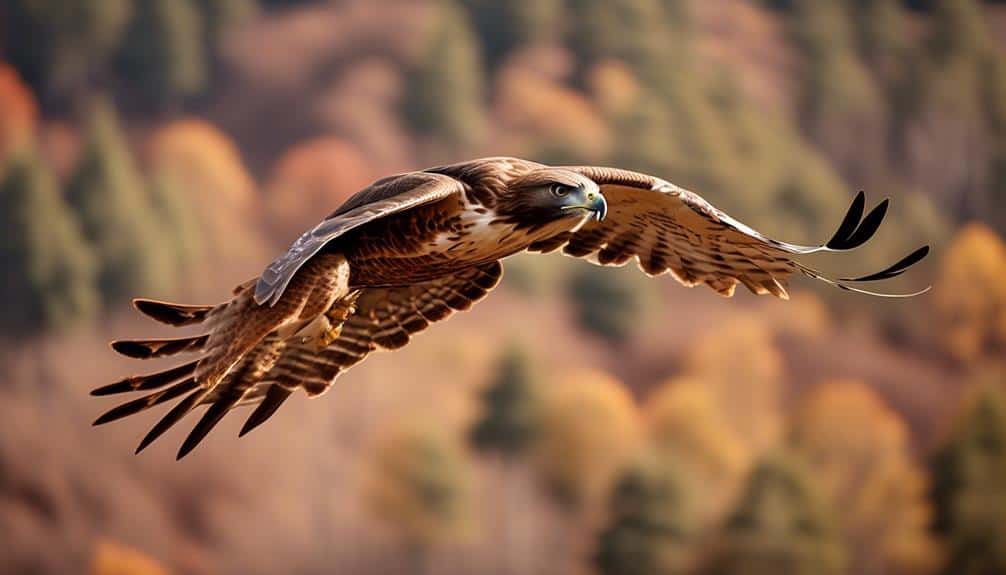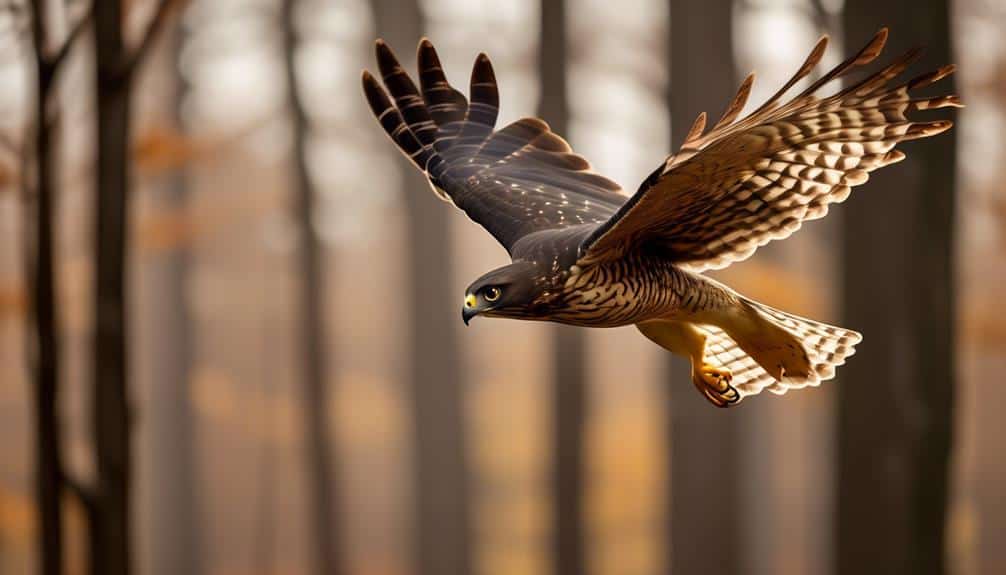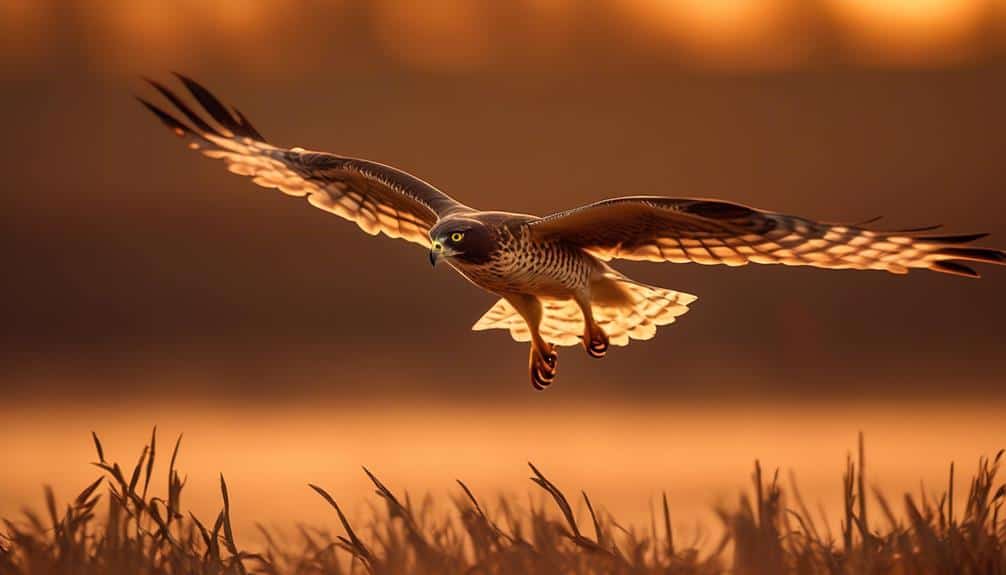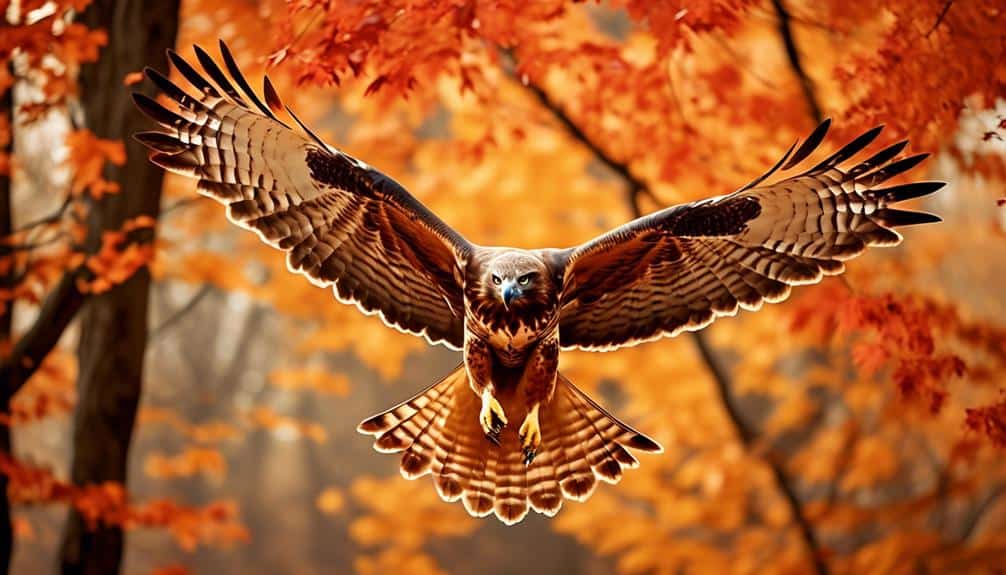When it comes to the diverse avian inhabitants of the Garden State, New Jersey boasts an impressive array of birds of prey. From the majestic Bald Eagles soaring high above to the stealthy hunters like the Great Horned Owls, these magnificent creatures command our attention and admiration.
With their keen eyesight, razor-sharp talons, and unparalleled hunting skills, these birds play an essential role in maintaining the delicate balance of our ecosystems.
But what secrets lie beneath the surface? What untold stories do these winged predators hold?
It is within these pages that we embark on a journey, uncovering the captivating world of New Jersey's birds of prey and the wonders they bring.
Bald Eagles

Bald eagles, known for their impressive wingspan and distinctive white head, are a majestic species of birds of prey found in New Jersey. As a scientist studying these magnificent creatures, I've come to appreciate their unique nesting habits and the conservation efforts that have been put in place to protect their population.
Bald eagles typically build their nests in tall trees near bodies of water, such as rivers or lakes. These nests, known as eyries, are large structures made of sticks and lined with soft materials like moss or grass. The eagles often return to the same nest year after year, adding new materials to reinforce it. These nesting habits are crucial for the survival of the species, as they provide a safe and secure environment for raising their young.
In recent years, bald eagle conservation efforts in New Jersey have been successful in increasing their population. These efforts include protecting their nesting sites from disturbance, regulating pesticide use to prevent contamination of their food sources, and implementing education programs to raise awareness about the importance of these iconic birds. Through these initiatives, the number of nesting pairs has steadily increased, leading to a remarkable recovery of the bald eagle population in the state.
Red-tailed Hawks

After studying the nesting habits and conservation efforts of bald eagles, it's now important to examine the remarkable species of red-tailed hawks found in New Jersey.
Red-tailed hawks (Buteo jamaicensis) are one of the most common and widely distributed raptors in North America. Here are four key aspects of their behavior and hunting techniques:
- Behavior patterns: Red-tailed hawks are known for their soaring flight, often seen circling high in the sky. They've broad wings and a characteristic red tail, which becomes more pronounced as they mature. These hawks are territorial and will defend their nesting areas fiercely. They're also monogamous and form long-term pair bonds.
- Hunting techniques: Red-tailed hawks are primarily opportunistic hunters, preying on a variety of small mammals, birds, reptiles, and even carrion. They use their keen eyesight to scan the ground below for potential prey. Once a target is spotted, they'll swoop down with remarkable speed and agility, using their sharp talons to capture and kill their prey. Sometimes, they employ a technique called 'stooping,' where they dive from great heights to surprise their prey.
- Nesting and breeding: Red-tailed hawks build large stick nests in tall trees or on cliffs. They often return to the same nest year after year, adding new material to reinforce it. Breeding season typically starts in early spring, and the female lays 1 to 3 eggs. Both parents take turns incubating the eggs and caring for the young.
- Conservation status: Red-tailed hawks aren't currently considered a threatened species. They've adapted well to human-modified landscapes and can be found in a variety of habitats, including forests, grasslands, and urban areas. However, habitat loss and fragmentation, as well as pesticide use, can still pose challenges to their long-term survival.
Great Horned Owls

Great Horned Owls (Bubo virginianus), known for their distinctive ear tufts and powerful talons, are a formidable species of birds of prey found in New Jersey. These majestic owls have a wide range of habitat preferences, allowing them to thrive in various environments across the state. They can be found in dense forests, open woodlands, swamps, and even suburban areas. Great Horned Owls are highly adaptable and can nest in a variety of locations, including abandoned nests made by other birds, tree cavities, and even on the ground.
When it comes to breeding behaviors, Great Horned Owls typically mate for life. Breeding season begins in early winter, with courtship displays and vocalizations used to attract a mate. The female lays 1 to 4 eggs, which she incubates for about a month, while the male provides her with food. Once the eggs hatch, both parents take turns feeding and caring for the young. The owlets remain in the nest for several weeks, gradually developing their flight feathers and learning essential hunting skills from their parents.
Peregrine Falcons

Peregrine Falcons (Falco peregrinus) are a species of birds of prey known for their exceptional hunting abilities and incredible speed. Here are some key facts about Peregrine Falcons:
- Conservation efforts: Peregrine Falcons faced a significant decline in their population due to pesticide use in the mid-20th century. However, through dedicated conservation efforts, their numbers have rebounded. Organizations such as the Peregrine Fund and local governments have implemented measures to protect nesting sites and monitor populations. These efforts have been successful in ensuring the survival and recovery of this magnificent species.
- Migration patterns: Peregrine Falcons are known for their impressive migratory journeys. They travel long distances, following a predictable pattern. In North America, they breed in the Arctic and subarctic regions and migrate south during the winter months. Some individuals from the eastern population of North America undertake extensive journeys, traveling as far as South America.
- Adaptations for speed: Peregrine Falcons have several adaptations that enable them to reach incredible speeds during their hunting dives, or 'stoops.' Their streamlined bodies, long pointed wings, and strong flight muscles allow them to achieve speeds of over 240 miles per hour (386 kilometers per hour). Their exceptional vision also plays a crucial role in their hunting success.
- Ecosystem role: Peregrine Falcons play a vital role in maintaining the balance of ecosystems. As top predators, they control populations of smaller birds and mammals, preventing overpopulation and ensuring the health of the prey species.
Peregrine falcon conservation efforts have been instrumental in protecting this remarkable species, while their remarkable migration patterns contribute to the awe and wonder surrounding these birds of prey.
Cooper's Hawks

Cooper's Hawks (Accipiter cooperii) are a species of birds of prey known for their agile hunting techniques and ability to navigate dense forested areas. These medium-sized hawks are found across North America, including New Jersey, where they thrive in a variety of habitats.
Habitat preferences are an important aspect of Cooper's Hawks' ecology. They are commonly found in woodlands, forests, and even urban areas with mature trees. Unlike some other hawk species, Cooper's Hawks are well adapted to hunting in cluttered environments. Their long tails and rounded wings allow them to maneuver through dense vegetation, making them highly skilled at chasing prey through the forest canopy.
Breeding behavior is another fascinating aspect of Cooper's Hawks' biology. They are monogamous birds, forming long-term pair bonds. Breeding pairs construct their nests in the forks of trees, usually located high off the ground for protection. These nests are composed of sticks and lined with softer materials like bark and leaves.
To better understand the habitat preferences and breeding behavior of Cooper's Hawks, let's take a closer look at the table below:
| Habitat Preferences | Breeding Behavior | |
|---|---|---|
| 1 | Woodlands and forests | Monogamous |
| 2 | Urban areas with mature trees | Nest construction in tree forks |
| 3 | Ability to navigate dense vegetation | High nest placement for protection |
Northern Harriers

Northern Harriers (Circus hudsonius) are raptors known for their low-flying hunting techniques and distinctive white rump patch. These fascinating birds have specific habitat preferences and employ unique hunting techniques to capture their prey.
- Habitat Preferences:
Northern Harriers can be found in a variety of habitats, including marshes, meadows, grasslands, and fields. They prefer open areas with low vegetation, such as wetlands and coastal marshes. These habitats provide the harriers with optimal conditions for hunting and nesting.
- Hunting Techniques:
Unlike other raptors that soar high in the sky, Northern Harriers fly low to the ground while hunting. This technique, known as 'quartering,' involves flying back and forth over the ground, scanning for prey. Their keen eyesight and acute hearing help them locate small mammals, birds, reptiles, and insects. Once they spot their prey, harriers swoop down to catch it with their sharp talons.
- Stealth and Agility:
Northern Harriers possess long wings and a long tail, which aid in their agile flight. They've a distinctive facial disk that enhances their hearing, allowing them to pinpoint the exact location of their prey. This stealth and agility make them highly efficient hunters.
- Adaptations for Hunting:
The Northern Harrier's facial disk isn't only for hearing but also plays a crucial role in improving their vision. It acts as a natural sunshade, reducing glare and enhancing contrast. This adaptation enables harriers to spot their prey more easily, even in bright sunlight.
Frequently Asked Questions
How Do These Birds of Prey Find Their Food?
Birds of prey find their food through various bird hunting techniques and prey detection methods. They use their keen eyesight, sharp talons, and powerful beaks to spot, capture, and consume their prey.
What Are the Typical Nesting Habits of These Birds?
Nesting patterns and breeding behavior vary among birds of prey. They build intricate nests, utilizing materials like twigs and grass. Males often court females with elaborate displays. Understanding these behaviors can provide insights into their reproductive success.
Are There Any Specific Conservation Efforts in Place for These Species in New Jersey?
There are specific conservation efforts in place for these species in New Jersey, focusing on habitat protection. These efforts aim to preserve and restore suitable nesting and foraging areas, ensuring the long-term survival of these birds.
How Do the Populations of These Birds of Prey Differ in Urban Areas Versus Rural Areas?
In urban areas, the populations of these birds of prey tend to be smaller compared to rural areas. This is mainly due to differences in habitat preferences, as urban environments may not provide suitable hunting grounds and nesting sites.
Do These Birds of Prey Migrate, and if So, Where Do They Go During the Winter Months?
During the winter months, birds of prey migrate to more favorable habitats with abundant food supply. They have developed various adaptations for surviving winter, such as growing thicker feathers and reducing their metabolic rate.
Conclusion
In conclusion, New Jersey is home to a diverse array of birds of prey. These magnificent creatures play a vital role in maintaining the ecological balance of the region. Their presence in New Jersey's skies is a testament to the rich biodiversity and natural beauty of this state.
The birds of prey found in New Jersey include the majestic Bald Eagles, the powerful Red-tailed Hawks, the wise Great Horned Owls, the swift Peregrine Falcons, the agile Cooper's Hawks, and the graceful Northern Harriers.







